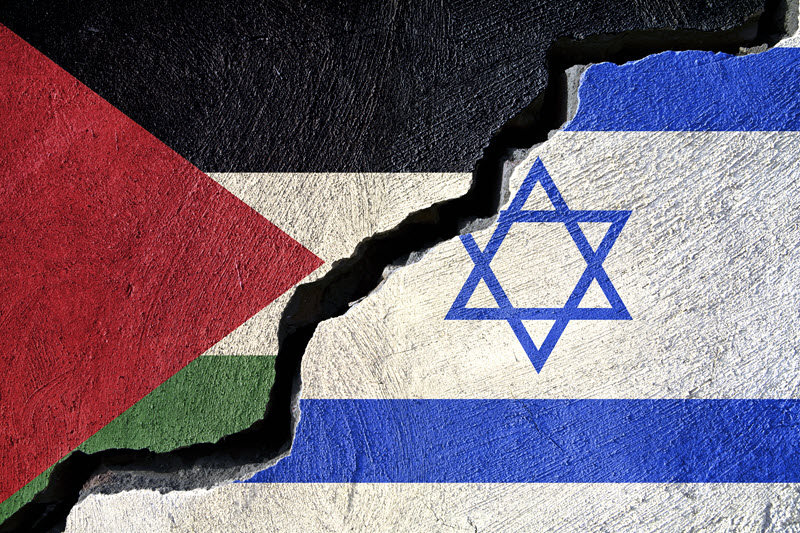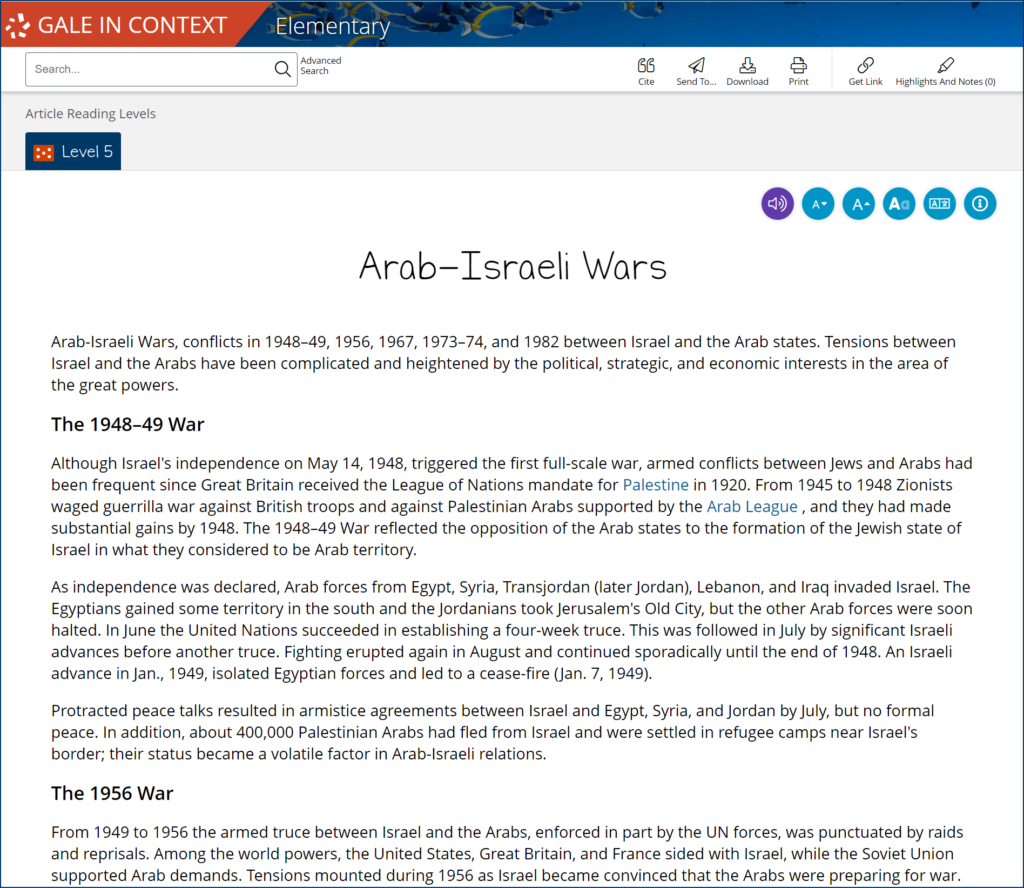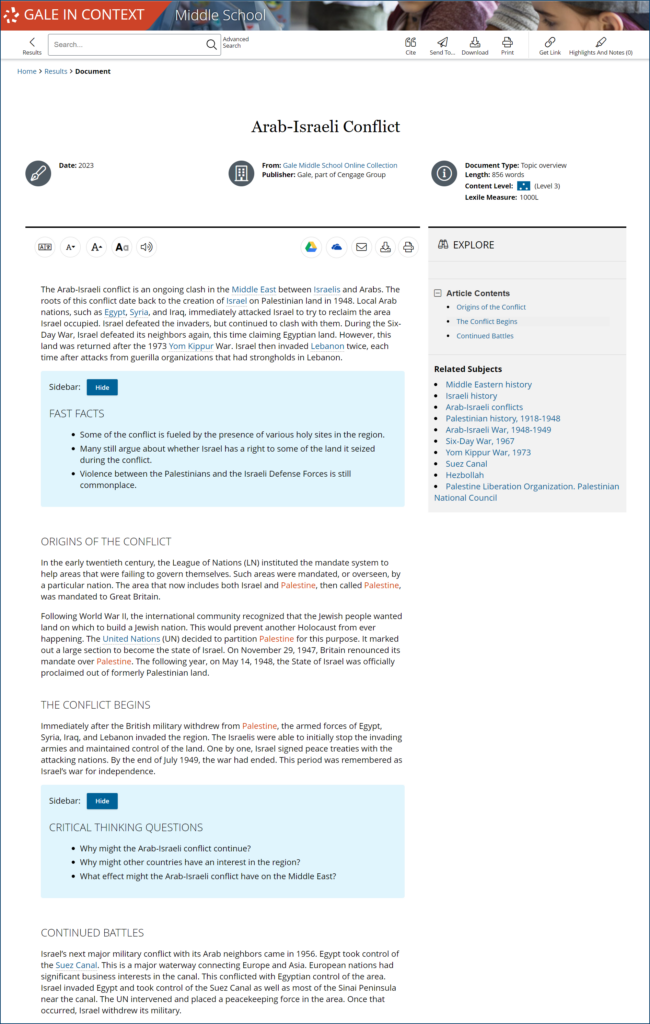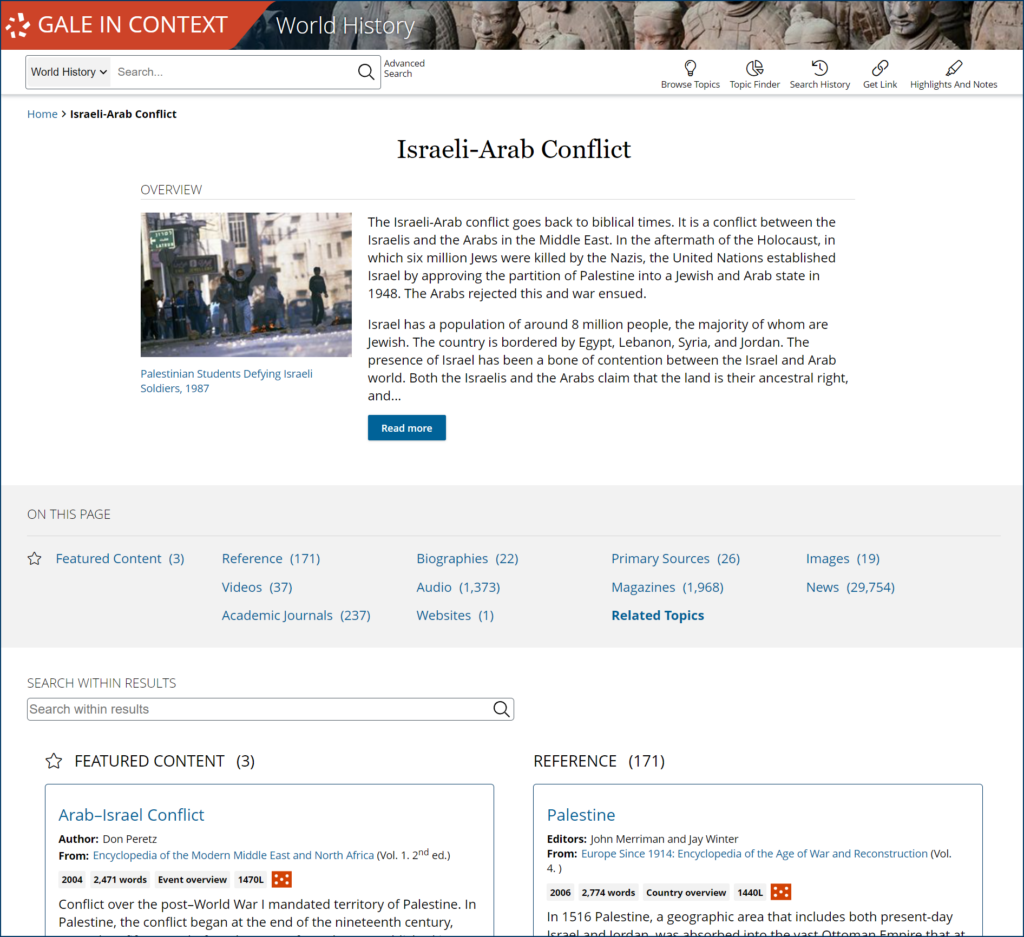| By Gale Staff |
From Jerusalem to Gaza to the West Bank, the people of Israel and Palestine are living amid a decades-long clash over borders, settlements, security, and statehood. This seemingly intractable dispute has claimed thousands of lives while defying resolution.
As education providers, all of us strive to approach this profoundly complex topic with care and sensitivity. Rather than advocate specific views, our role as educators is to equip students and patrons with rich materials to strengthen understanding.
At Gale, we aim to provide just that: resources that inspire thoughtful analysis and constructive dialogue among students and researchers alike.
Getting Started
Many people across the world are likely unaware of the tangled history between Israeli-Palestinian. With such a polarizing issue, it’s crucial to help students identify objective, factual sources that allow them to form well-rounded perspectives.
There is no shortage of information available, but accuracy and trustworthiness across the multifarious number of potential news and history sources vary.
Comparing stories on the same news event reveals how tone and word choice shape interpretations. This builds a deep understanding of how information gets framed to influence audiences. But, with quality sources in hand, structured discussions and debates allow students to articulate and defend their own perspectives while critically considering others.
Israel & Palestine: A Brief Overview
For upper elementary reading: The area known as Israel-Palestine has a long history as a crossroads for religion and culture. Three major faiths—Judaism, Christianity, and Islam—consider it a holy land. In the 1900s, the Zionist movement led to increased Jewish immigration. Tensions arose between Jewish immigrants and Arab residents. After WWII, the UN proposed dividing it into independent Jewish and Arab states, but war broke out. Explore this history further in Gale In Context: Elementary.
For middle school reading: Great Britain gained control of the area after WWI and administered it as Palestine. Jewish immigration continued, sparking Arab resentment. In 1947, the UN endorsed the Partition Plan to create independent Jewish and Arab states, but war erupted in 1948. At the end of this First Arab-Israeli War, Israel controlled more land than the UN planned. Examine the impact of wars and negotiations from 1948-1993 in Gale In Context: Middle School.
For high school/college reading: The 1993 Oslo Accords were a high point of Israeli-Palestinian negotiations as leaders recognized each other and agreed to interim self-governance for Palestinians. But talks stalled amid violence. The failure of diplomacy, the growth of Israeli settlements, Hamas’ rule in Gaza, and other factors perpetuated the impasse. Survey the peace process challenges in scholarly articles via Gale In Context: World History.
Leadership’s Impact on Culture
A nation’s leadership profoundly shapes public attitudes and identity on divisive issues.
Students can trace how dominant narratives in Israeli and Palestinian society evolved under different leaders.
For instance, contrast perspectives from Rabin’s Oslo era with those under hardliners like Netanyahu today. Textbook passages, speeches, and media from respective time periods reveal how leaders amplify certain ideologies. Comparing prevailing views across eras illustrates leadership’s power to unify or polarize public opinion. This helps students gain nuanced insight into each culture while avoiding stereotyping diverse groups.
Profiles in Leadership
For upper elementary reading: Palestinian leader Yasser Arafat, a founding father of Fatah and the PLO, strove for an independent Palestinian state. Though controversial, he won the Nobel Peace Prize for courageously negotiating the Oslo Accords with Israeli leader Yitzhak Rabin. Discover more about these leaders’ traits in Gale In Context: Elementary.
For middle/high school reading: Benjamin Netanyahu, Israel’s longest-serving PM, promotes Jewish settlements and tougher security, impeding peace talks. Yet he built Israel’s economy. Mahmoud Abbas, President of the Palestinian Authority, cooperated with the US and Israel but now pursues statehood through global institutions. Examine Benjamin Netanyahu and Mahmoud Abbas‘s approaches via Gale In Context: Biography.
The Ripple Effect of Education in Conflict Resolution
Education can ripple out to illuminate potential paths to conflict resolution.
This transformation happens in three significant stages: exposure to multiple perspectives, fostering empathy, and making an impact worldwide.
Exposure to Multiple Perspectives
Behind every conflict, multiple perspectives shape unique narratives. Gale resources allow researchers to explore content they can trust and encourage rigorous examination of original documents from diverse perspectives. Students can analyze historical speeches, treaties, letters, diary entries, maps, photos, and artwork to uncover first-hand experiences and views from both sides. For instance, exploring personal writings of early Zionist pioneers and displaced Palestinian peasants humanizes how rising tensions impacted ordinary people.
Fostering Empathy and Understanding
Resources rich in personal stories and firsthand accounts humanize global conflicts. Learners connect with individuals affected, shifting focus from political strategies to how violence impacts real lives. This fosters empathy across divides—a key ingredient for resolution.
Worldwide Impact
The Israel-Palestine conflict impacts global diasporas, including Arab-Americans and Jewish-Americans living closely in U.S. communities. Students can apply lessons from afar to promote understanding and peacebuilding at home; for example, by starting campus dialogues, writing op-eds highlighting diverse voices, or volunteering with local refugee resettlement projects.
The work of education and objectivity is exceedingly critical work that not only impacts the individual but the world they affect. By providing balanced resources illuminating multifaceted topics, we aim to empower learners to engage with complexity and hopefully light paths to progress.
Find More Topics
The conflict touches on many issues, from refugees to human rights to religious divisions. Gale In Context offers vast, diverse content:
Global Perspectives – Examine personal stories of cooperation between everyday Israelis and Palestinians through Gale In Context: Global Issues.
Geography & Environment – Assess the dispute over water resources in the Jordan River valley through Gale In Context: World History.
Politics & Government – Analyze the role of US foreign policy in peace efforts through Gale In Context: World History.
Culture & Society – Explore how artists, writers, and leaders convey identity and resistance through Gale In Context: Biography.
Enhance Your Educational Initiatives with Gale
The Israel-Palestine conflict is complex, polarizing, and tragic. But exploring its history and perspectives in our classrooms and libraries is itself an act of hope. Now more than ever, it’s essential to have frank, open conversations about global issues.
By working together to foster thoughtful research and discussion, we can help illuminate paths to knowledge and progress.
Find out if your local educational institution or library has access to Gale resources.
To learn more about Gale resources or to request a trial, contact your rep today.




